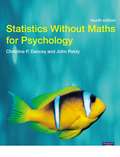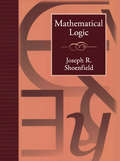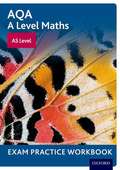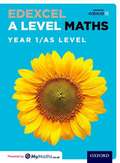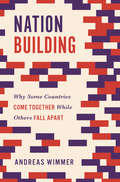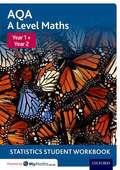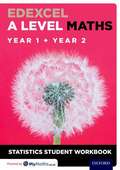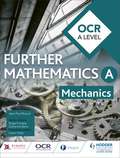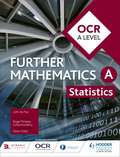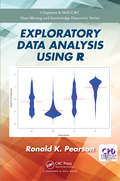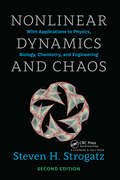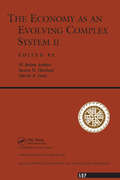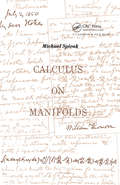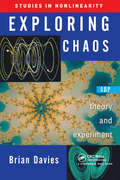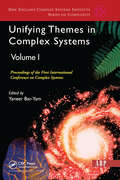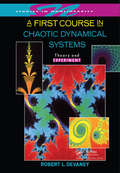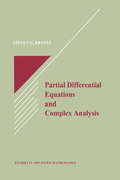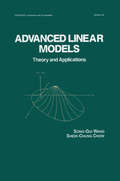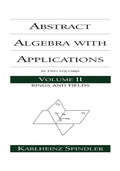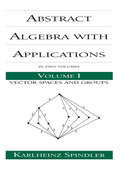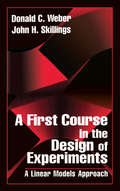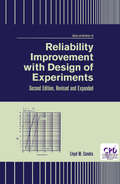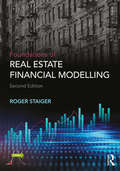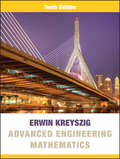- Table View
- List View
Statistics Without Maths for Psychology (PDF)
by Christine P. Dancey John ReidyStatistics Without Maths for Psychology is an essential companion to any psychology course, guiding students through the process of using statistics without mathematical formulae. It provides the tools to use SPSS and gives clear but comprehensive explanations of all the statistical concepts needed. This text offers students the opportunity to test their knowledge and practice their skills with activities, exercises and multiple choice questions, and is packed with up-to-date examples, “discussion points” and handy tips to aid them in their studies.
Mathematical Logic
by Joseph R. ShoenfieldThis classic introduction to the main areas of mathematical logic provides the basis for a first graduate course in the subject. It embodies the viewpoint that mathematical logic is not a collection of vaguely related results, but a coherent method of attacking some of the most interesting problems, which face the mathematician. The author presents the basic concepts in an unusually clear and accessible fashion, concentrating on what he views as the central topics of mathematical logic: proof theory, model theory, recursion theory, axiomatic number theory, and set theory. There are many exercises, and they provide the outline of what amounts to a second book that goes into all topics in more depth. This book has played a role in the education of many mature and accomplished researchers.
AQA A Level Maths: AS Level Exam h2018
by DavidThis book provides mock papers for the new 2017 AQA AS Level (first exams in 2018). Mock papers are the ideal revision resource for AS Level maths, and these have been created to perfectly match the style and content of the new linear exams. The book contains 3 sets of AS papers, therefore six papers in total. With rubric at the front, and space to write answers directly onto the page, this book provides realistic practice of the actual exam. Answers are in the back of the book with the full mark scheme available online.
Edexcel A Level Maths: Year 1 / As Student Book
by Paul Williams Robert Wagner David Baker Brian Jefferson Garry Wiseman Mark Rowland David Bowles Mike Heylings John Rayneau Eddie Mullan Katie WoodPlease note this title is suitable for any student studying:- Exam Board: Edexcel - Level: AS/A Level - Subject: Maths - First teaching: September 2017 - First exams: June 2018This Student Book has been endorsed for Edexcel and provides full support for both their new linear AS Level specification, and for the first year of the full A Level course. Covering all the pure maths, mechanics and statistics content needed, the book provides dedicated exercises in every chapter for exam-style problem-solving and modelling questions. Dedicated revision exercises test synoptically across the curriculum. Throughout the book, the explanatory text is clear and concise, with abundant worked examples to show how key techniques can be used and common pitfalls to avoid. Short answers are in the back of the book, while full step-by-step solutions are provided online. MyMaths links appear at the bottom of all exercises, providing a quick route to further practice and support.
Nation Building: Why Some Countries Come Together While Others Fall Apart (Princeton Studies in Global and Comparative Sociology)
by Andreas WimmerA new and comprehensive look at the reasons behind successful or failed nation buildingNation Building presents bold new answers to an age-old question. Why is national integration achieved in some diverse countries, while others are destabilized by political inequality between ethnic groups, contentious politics, or even separatism and ethnic war? Traversing centuries and continents from early nineteenth-century Europe and Asia to Africa from the turn of the twenty-first century to today, Andreas Wimmer delves into the slow-moving forces that encourage political alliances to stretch across ethnic divides and build national unity.Using datasets that cover the entire world and three pairs of case studies, Wimmer’s theory of nation building focuses on slow-moving, generational processes: the spread of civil society organizations, linguistic assimilation, and the states’ capacity to provide public goods. Wimmer contrasts Switzerland and Belgium to demonstrate how the early development of voluntary organizations enhanced nation building; he examines Botswana and Somalia to illustrate how providing public goods can bring diverse political constituencies together; and he shows that the differences between China and Russia indicate how a shared linguistic space may help build political alliances across ethnic boundaries.Wimmer then reveals, based on the statistical analysis of large-scale datasets, that these mechanisms are at work around the world and explain nation building better than competing arguments such as democratic governance or colonial legacies. He also shows that when political alliances crosscut ethnic divides and when most ethnic communities are represented at the highest levels of government, the general populace will identify with the nation and its symbols, further deepening national political integration.Offering a long-term historical perspective and global outlook, Nation Building sheds important new light on the challenges of political integration in diverse countries.
Nation Building: Why Some Countries Come Together While Others Fall Apart (Princeton Studies in Global and Comparative Sociology)
by Andreas WimmerA new and comprehensive look at the reasons behind successful or failed nation buildingNation Building presents bold new answers to an age-old question. Why is national integration achieved in some diverse countries, while others are destabilized by political inequality between ethnic groups, contentious politics, or even separatism and ethnic war? Traversing centuries and continents from early nineteenth-century Europe and Asia to Africa from the turn of the twenty-first century to today, Andreas Wimmer delves into the slow-moving forces that encourage political alliances to stretch across ethnic divides and build national unity.Using datasets that cover the entire world and three pairs of case studies, Wimmer’s theory of nation building focuses on slow-moving, generational processes: the spread of civil society organizations, linguistic assimilation, and the states’ capacity to provide public goods. Wimmer contrasts Switzerland and Belgium to demonstrate how the early development of voluntary organizations enhanced nation building; he examines Botswana and Somalia to illustrate how providing public goods can bring diverse political constituencies together; and he shows that the differences between China and Russia indicate how a shared linguistic space may help build political alliances across ethnic boundaries.Wimmer then reveals, based on the statistical analysis of large-scale datasets, that these mechanisms are at work around the world and explain nation building better than competing arguments such as democratic governance or colonial legacies. He also shows that when political alliances crosscut ethnic divides and when most ethnic communities are represented at the highest levels of government, the general populace will identify with the nation and its symbols, further deepening national political integration.Offering a long-term historical perspective and global outlook, Nation Building sheds important new light on the challenges of political integration in diverse countries.
Maths: ALevel Year1 and 2
by David BakerAt the back of this book, you will find the Statistics formulae that you will be provided in an exam, as well as those that you will need to learn. Calculators All papers are calculator papers. You must therefore make sure that you have a calculator and that you know how to use it for all topics covered. The rules on which calculators are allowed can be found in the Joint Council for General Qualifications document
Exploratory Data Analysis Using R (Chapman and Hall/CRC Data Mining and Knowledge Discovery Series)
by Ronald K. PearsonExploratory Data Analysis Using R provides a classroom-tested introduction to exploratory data analysis (EDA) and introduces the range of "interesting" – good, bad, and ugly – features that can be found in data, and why it is important to find them. It also introduces the mechanics of using R to explore and explain data. The book begins with a detailed overview of data, exploratory analysis, and R, as well as graphics in R. It then explores working with external data, linear regression models, and crafting data stories. The second part of the book focuses on developing R programs, including good programming practices and examples, working with text data, and general predictive models. The book ends with a chapter on "keeping it all together" that includes managing the R installation, managing files, documenting, and an introduction to reproducible computing. The book is designed for both advanced undergraduate, entry-level graduate students, and working professionals with little to no prior exposure to data analysis, modeling, statistics, or programming. it keeps the treatment relatively non-mathematical, even though data analysis is an inherently mathematical subject. Exercises are included at the end of most chapters, and an instructor's solution manual is available. About the Author: Ronald K. Pearson holds the position of Senior Data Scientist with GeoVera, a property insurance company in Fairfield, California, and he has previously held similar positions in a variety of application areas, including software development, drug safety data analysis, and the analysis of industrial process data. He holds a PhD in Electrical Engineering and Computer Science from the Massachusetts Institute of Technology and has published conference and journal papers on topics ranging from nonlinear dynamic model structure selection to the problems of disguised missing data in predictive modeling. Dr. Pearson has authored or co-authored books including Exploring Data in Engineering, the Sciences, and Medicine (Oxford University Press, 2011) and Nonlinear Digital Filtering with Python. He is also the developer of the DataCamp course on base R graphics and is an author of the datarobot and GoodmanKruskal R packages available from CRAN (the Comprehensive R Archive Network).
Nonlinear Dynamics and Chaos: With Applications to Physics, Biology, Chemistry, and Engineering
by Steven H. StrogatzThis textbook is aimed at newcomers to nonlinear dynamics and chaos, especially students taking a first course in the subject. The presentation stresses analytical methods, concrete examples, and geometric intuition. The theory is developed systematically, starting with first-order differential equations and their bifurcations, followed by phase plane analysis, limit cycles and their bifurcations, and culminating with the Lorenz equations, chaos, iterated maps, period doubling, renormalization, fractals, and strange attractors.
The Economy As An Evolving Complex System II
by W. Brian ArthurA new view of the economy as an evolving, complex system has been pioneered at the Santa Fe Institute over the last ten years, This volume is a collection of articles that shape and define this view?a view of the economy as emerging from the interactions of individual agents whose behavior constantly evolves, whose strategies and actions are always adapting.The traditional framework in economics portrays activity within an equilibrium steady state. The interacting agents in the economy are typically homogenous, solve well-defined problems using perfect rationality, and act within given legal and social structures. The complexity approach, by contrast, sees economic activity as continually changing?continually in process. The interacting agents are typically heterogeneous, they must cognitively interpret the problems they face, and together they create the structures?markets, legal and social institutions, price patters, expectations?to which they individually react. Such structures may never settle down. Agents may forever adapt and explore and evolve their behaviors within structures that continually emerge and change and disappear?structures these behaviors co-create. This complexity approach does not replace the equilibrium one?it complements it.The papers here collected originated at a recent conference at the Santa Fe Institute, which was called to follow up the well-known 1987 SFI conference organized by Philip Anderson, Kenneth Arrow, and David Pines. They survey the new study of complexity and the economy. They apply this approach to real economic problems and they show the extent to which the initial vision of the 1987 conference has come to fruition.
Calculus On Manifolds: A Modern Approach To Classical Theorems Of Advanced Calculus
by Michael SpivakThis little book is especially concerned with those portions of ?advanced calculus? in which the subtlety of the concepts and methods makes rigor difficult to attain at an elementary level. The approach taken here uses elementary versions of modern methods found in sophisticated mathematics. The formal prerequisites include only a term of linear algebra, a nodding acquaintance with the notation of set theory, and a respectable first-year calculus course (one which at least mentions the least upper bound (sup) and greatest lower bound (inf) of a set of real numbers). Beyond this a certain (perhaps latent) rapport with abstract mathematics will be found almost essential.
Exploring Chaos: Theory And Experiment
by Brian DaviesThis book presents elements of the theory of chaos in dynamical systems in a framework of theoretical understanding coupled with numerical and graphical experimentation. The theory is developed using only elementary calculus and algebra, and includes dynamics of one-and two-dimensional maps, periodic orbits, stability and its quantification, chaotic behavior, and bifurcation theory of one-dimensional systems. There is an introduction to the theory of fractals, with an emphasis on the importance of scaling, and a concluding chapter on ordinary differential equations. The accompanying software, written in Java, is available online (see link below). The program enables students to carry out their own quantitative experiments on a variety of nonlinear systems, including the analysis of fixed points of compositions of maps, calculation of Fourier spectra and Lyapunov exponents, and box counting for two-dimensional maps. It also provides for visualizing orbits, final state and bifurcation diagrams, Fourier spectra and Lyapunov exponents, basins of attractions, three-dimensional orbits, Poincar?ections, and return maps. Please visit http://www.maths.anu.edu.au/~briand/chaos/ for the integrated cross-platform software.
Unifying Themes In Complex Systems, Volume 1: Proceedings Of The First International Conference On Complex Systems
by Yaneer Bar-YamThe study of complex systems has attracted a broad range of researchers from many disciplines spanning both the hard and soft sciences. In the Autumn of 1997, 300 of these researchers came together for the First International Conference on Complex Systems. The proceedings of this conference is the first book in the New England Complex Systems Institute Series on Complexity and includes more than 100 presentations and papers on topics like evolution, emergence, complexity, self-organization, scaling, informatics, time series, emergence of mind, and engineering of complex systems.
A First Course In Chaotic Dynamical Systems: Theory And Experiment
by Robert L. DevaneyA First Course in Chaotic Dynamical Systems: Theory and Experiment is the first book to introduce modern topics in dynamical systems at the undergraduate level. Accessible to readers with only a background in calculus, the book integrates both theory and computer experiments into its coverage of contemporary ideas in dynamics. It is designed as a gradual introduction to the basic mathematical ideas behind such topics as chaos, fractals, Newton's method, symbolic dynamics, the Julia set, and the Mandelbrot set, and includes biographies of some of the leading researchers in the field of dynamical systems. Mathematical and computer experiments are integrated throughout the text to help illustrate the meaning of the theorems presented. Chaotic Dynamical Systems Software, Labs 1-6 is a supplementary labouratory software package, available separately, that allows a more intuitive understanding of the mathematics behind dynamical systems theory. Combined with A First Course in Chaotic Dynamical Systems , it leads to a rich understanding of this emerging field.
Partial Differential Equations and Complex Analysis (Studies in Advanced Mathematics #6)
by Steven G. KrantzEver since the groundbreaking work of J.J. Kohn in the early 1960s, there has been a significant interaction between the theory of partial differential equations and the function theory of several complex variables. Partial Differential Equations and Complex Analysis explores the background and plumbs the depths of this symbiosis. The book is an excellent introduction to a variety of topics and presents many of the basic elements of linear partial differential equations in the context of how they are applied to the study of complex analysis. The author treats the Dirichlet and Neumann problems for elliptic equations and the related Schauder regularity theory, and examines how those results apply to the boundary regularity of biholomorphic mappings. He studies the ?-Neumann problem, then considers applications to the complex function theory of several variables and to the Bergman projection.
Advanced Linear Models: Theory and Applications
by Shein-Chung ChowThis work details the statistical inference of linear models including parameter estimation, hypothesis testing, confidence intervals, and prediction. The authors discuss the application of statistical theories and methodologies to various linear models such as the linear regression model, the analysis of variance model, the analysis of covariance model, and the variance components model.
Abstract Algebra with Applications: Volume 2: Rings and Fields
by Karlheinz SpindlerA comprehensive presentation of abstract algebra and an in-depth treatment of the applications of algebraic techniques and the relationship of algebra to other disciplines, such as number theory, combinatorics, geometry, topology, differential equations, and Markov chains.
Abstract Algebra with Applications: Volume 1: Vector Spaces and Groups (Pure and Applied Mathematics)
by Karlheinz SpindlerA comprehensive presentation of abstract algebra and an in-depth treatment of the applications of algebraic techniques and the relationship of algebra to other disciplines, such as number theory, combinatorics, geometry, topology, differential equations, and Markov chains.
A First Course in the Design of Experiments: A Linear Models Approach
by John H. SkillingsMost texts on experimental design fall into one of two distinct categories. There are theoretical works with few applications and minimal discussion on design, and there are methods books with limited or no discussion of the underlying theory. Furthermore, most of these tend to either treat the analysis of each design separately with little attempt to unify procedures, or they will integrate the analysis for the designs into one general technique.A First Course in the Design of Experiments: A Linear Models Approach stands apart. It presents theory and methods, emphasizes both the design selection for an experiment and the analysis of data, and integrates the analysis for the various designs with the general theory for linear models. The authors begin with a general introduction then lead students through the theoretical results, the various design models, and the analytical concepts that will enable them to analyze virtually any design. Rife with examples and exercises, the text also encourages using computers to analyze data. The authors use the SAS software package throughout the book, but also demonstrate how any regression program can be used for analysis.With its balanced presentation of theory, methods, and applications and its highly readable style, A First Course in the Design of Experiments proves ideal as a text for a beginning graduate or upper-level undergraduate course in the design and analysis of experiments.
Reliability Improvement with Design of Experiment, Second Edition, (Quality and Reliability)
by Lloyd CondraA guide to implementing and operating a practical reliability program using carefully designed experiments to provide information quickly, efficiently and cost effectively. It emphasizes real world solutions to daily problems. The second edition contains a special expanded section demonstrating how to combine accelerated testing with design of experiments for immediate improvement.
Foundations of Real Estate Financial Modelling
by Roger StaigerFoundations of Real Estate Financial Modelling, Second Edition is specifically designed to provide the scalable basis of pro forma modelling for real estate projects. The book introduces students and professionals to the basics of real estate finance theory prior to providing a step-by-step guide for financial real estate model construction using Excel. The book introduces an innovative new financial metric, P(Gain), which quantifies the probability of a Return of Capital and answers the most basic question for investing, "What is the probability I get my money back?".? This new second edition has been fully revised and expanded. The book is separated into three functional units: (1) Real Estate Valuation Basics, Theory and Skills, (2) Real Estate Pro Forma Modelling, (3) Real Estate Pro Forma (Enhancements). New and enhanced Chapters cover:? Interest rates Amortization Single- and multi-family unit Development module Rent roll module Waterfall (equity bifurcation) Hotel, retail/office and townhouse. ? In addition, this new edition includes problem sets and solutions at the end of each chapter as well as case studies underpinning the chapter topics. Further chapters are dedicated to risk quantification and include scenario, stochastic and Monte Carlo simulations, equity waterfalls, and adding U.S. GAAP financial statements to existing real estate pro forma models. This book is the ideal textbook for a Real Estate Finance class, providing the theoretical basis of real estate finance as well as valuable modelling skills for the workplace. This book provides individuals with a step-by-step instruction on how to construct a real estate financial model starting with a new spreadsheet. The resultant model is portable, scalable, and modular. A companion website provides the pro forma models to readers as a reference for their own constructed models.
Advanced Engineering Mathematics
by Erwin KreyszigThis market-leading text is known for its comprehensive coverage, careful and correct mathematics, outstanding exercises, and self contained subject matter parts for maximum flexibility. The new edition continues with the tradition of providing instructors and students with a comprehensive and up-to-date resource for teaching and learning engineering mathematics, that is, applied mathematics for engineers and physicists, mathematicians and computer scientists, as well as members of other disciplines.
